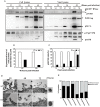Patients infected with CRF07_BC have significantly lower viral loads than patients with HIV-1 subtype B: mechanism and impact on disease progression
- PMID: 25502811
- PMCID: PMC4263662
- DOI: 10.1371/journal.pone.0114441
Patients infected with CRF07_BC have significantly lower viral loads than patients with HIV-1 subtype B: mechanism and impact on disease progression
Abstract
The circulating recombinant form (CRF) 07_BC is the most prevalent HIV-1 strain among injection drug users (IDUs) in Taiwan. It contains a 7 amino-acid deletion in its p6gag. We conducted a cohort study to compare viral loads and CD4 cell count changes between patients infected with subtype B and CRF07_BC and to elucidate its mechanism. Twenty-one patients infected with CRF07_BC and 59 patients with subtype B were selected from a cohort of 667 HIV-1/AIDS patients whom have been followed up for 3 years. Generalized estimated equation was used to analyze their clinical data and the results showed that patients infected with CRF07_BC had significantly lower viral loads (about 58,000 copies per ml less) than patients with subtype B infection (p = 0.002). The replicative capacity of nine CRF07_BC and four subtype B isolates were compared and the results showed that the former had significantly lower replicative capacity than the latter although all of them were CCR5- tropic and non-syncytium inducing viruses. An HIV-1-NL4-3 mutant virus which contains a 7 amino-acid deletion in p6gag (designated as 7d virus) was generated and its live cycle was investigated. The results showed that 7d virus had significantly lower replication capacity, poorer protease-mediated processing and viral proteins production. Electron microscopic examination of cells infected with wild-type or 7d virus demonstrated that the 7d virus had poorer and slower viral maturation processes: more viruses attached to the cell membrane and higher proportion of immature virions outside the cells. The interaction between p6gag and Alix protein was less efficient in cells infected with 7d virus. In conclusion, patients infected with CRF07_BC had significantly lower viral loads than patients infected with subtype B and it may due to the deletion of 7 amino acids which overlaps with Alix protein-binding domain of the p6gag.
Conflict of interest statement
Figures




References
-
- Vasan A, Renjifo B, Hertzmark E, Chaplin B, Msamanga G, et al. (2006) Different rates of disease progression of HIV type 1 infection in Tanzania based on infecting subtype. Clin Infect Dis 42:843–852. - PubMed
-
- Baeten JM, Chohan B, Lavreys L, Chohan V, McClelland RS, et al. (2007) HIV-1 subtype D infection is associated with faster disease progression than subtype A in spite of similar plasma HIV-1 loads. J Infect Dis 195:1177–1180. - PubMed
-
- Rangsin R, Piyaraj P, Sirisanthana T, Sirisopana N, Short O, et al. (2007) The natural history of HIV-1 subtype E infection in young men in Thailand with up to 14 years of follow-up. AIDS 21 Suppl 6 S39–46. - PubMed
-
- Pant Pai N, Shivkumar S, Cajas JM (2012) Does genetic diversity of HIV-1 non-B subtypes differentially impact disease progression in treatment-naive HIV-1-infected individuals? A systematic review of evidence: 1996-2010. J Acquir Immune Defic Syndr 59:382–388. - PubMed
-
- (2013) Center for Disease Control, ROC (Taiwan). HIV/AIDS data.
Publication types
MeSH terms
Substances
LinkOut - more resources
Full Text Sources
Other Literature Sources
Medical
Research Materials
Miscellaneous

